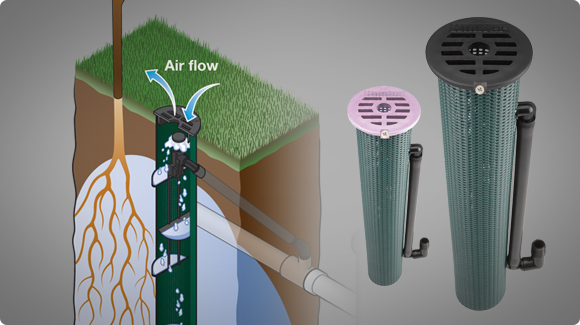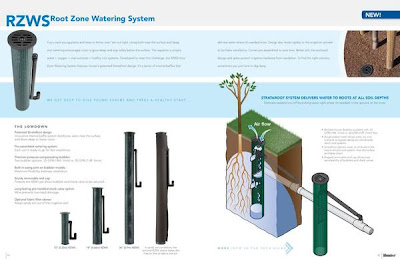HUNTER INDUSTRIES: Root Zone Watering systems
 |
| Image: Hunter Industries |
 |
| Image: Hunter Industires |
 |
| Image: Hunter Industries |
Page 24 of Irrigation Products 2008/2009 by Hunter Industries
"Root Zone Watering Systems = ( rzws ) RZWS root zone watering system delivers water where it s needed most design also lends rigidity to the irrigation cylinder to facilitate installation comes pre-assembled to save time better still the enclosed design and grate protect irrigation hardware from vandalism to find the right solution sometimes you just have to dig deep new if you want young plants and trees to thrive start `em out right using both near-the-surface and deep root watering encourages roots to grow deep and stay safely below the surface the equation is simple water oxygen vital nutrients healthy root systems developed to meet this challenge the rzws root zone watering system features hunter s patented strata root design it s a series of internal baffles that we get deep to give young shrubs and trees a healthy start strata root system delivers water to roots at all soil depths eliminate wasteful run-off by putting water right where it s needed in the ground at the roots the lowdown patented strata root design innovative internal baffle system distributes water near the surface and down deep to foster roots pre-assembled watering system each unit is ready to go for fast installation premium pressure-compensating bubbler two bubbler options .25 gpm 946 l/min or .50 gpm 1.89 l/min built-in swing joint on bubbler models maximum flexibility and easy installation sturdy removable end cap protects the rzws yet allows bubbler and check valve to be serviced long-lasting pre-installed check valve option valve prevents low-head drainage optional fabric filter sleeve keeps sandy soil out of the irrigation well air flow · reliable hunter bubbler available with.25 gpm 946 l/min or .50 gpm 1.89 l/min flow ·rough plastic mesh allows water,air,and nutrients to bypass dense soil and directly reach root systems · strata root delivers water to all levels of the tree or shrub s root system near the surface and deep down · rugged removable end cap allows easy serviceability of bubblers and check valves 10 0.25m rzws 46 18 0.46m rzws 36 0.9m rzws in sandy soil conditions the optional rzws sleeve keeps the interior free of debris and silt more info in the tech guide 47."
+StrataRoot+Systems.jpg) |
| image: Hunter Industries |
Eliminate wasteful run-off by putting water right where it's needed, in the ground, at the roots.
(1) Tough plastic mesh allows water, air and nutrients to bypass tough soils and directly reach root systems,
(2) Rugged removable end caps allow easy serviceability of bubblers and check valves.
(3) StrataRoot delivers water to all levels of the soil structure horizons of your trees or shrubs. Near the surface and deep down.
(4) These reliable Hunter Bubblers are available at .25 or .50 GPM flow.
Just to interject some teaching points here and help educate why most all trees and shrubs prefer deep water uptake, please look at what the science has discovered. These links below which reveal some of the work done by Prof Todd Dawson of University of California at Berkeley prove that Riparian Woodland Habitats foundational trees while clearly growing next to a rich water environment take most of their water hydration from very deep subsoil regions as opposed to the surface areas rich in a wealth of surface water. Now who in their right mind would ever consider such a puzzling phenomena and furthermore question why ? What is it about deep soil moisture that plants actually prefer in summertime as opposed to having a continual supply within the top layers always present ? Even without knowing the exact details to all these questions, clearly it would still be beneficial to replicate just such a system of deep earth hydration. For me, it appears more of a maintenance issue than a growth issue which would also eliminate Pest problems.
Important Links Below
Streamside Trees the do not use Stream Water
Deep-rooted plants have much greater impact on climate than experts thoughtBut that's the science of discovery and how nature really works. Armed with that kind of knowledge and understanding , you should be able to intelligently engineer your own landscape or habitat restoration project replicating brilliantly complex systems found out in the natural world which will greatly relieve much stress and hardships from your future maintenance workload. But you have to properly proceed and follow responsible steps while Trees & Shrubs are at a young early age. Wait years down the road and you'll pay for your irresponsible and could care less lazy attitude. It's like raising kids. Most modern day parents are not exactly hands on in continual training of their children from infancy through adolescence. A "Problem Child" could have been avoided, but as a result of ignorance or just the plain laziness of looking the other way and hoping things turn out alright, the parents are shackled to an unfortunate circumstance of their own making. True, sometimes specialized help and therapy can make a correction, but more often than not unlikely and the work load of trying to correct things later can be strenuous and back breaking.
 |
| The Hydro Source |
Same with plants, start traing early. Correct any problems early on. Prevent problems like girdling. Retail Nursery container planting systems more than likely will force roots to stay on the surface as opposed to driving deep. Careful pruning of the roots to remove the spinning inside container or even loosening of roots and spreading them out in a wider soil excavation will prevent this situation in the scene below where the tree is being strangled by it's own badly trained root system. And don't forget to inoculate with a great mycorrhizal and beneficial bacterial mix before planting.
 |
| http://hort.ifas.ufl.edu |
When storms rage then the larger more mature tree is not strong enough to stand up on it's own against such severe environmental forces. Same with young people. Deep emotional scares may never heal and quite often many go to the point of losing their lives because some parent early on gave no thought to problems they saw but ignored. Think about it folks. Both illustrate the same neglect. Even the above neglected tree pruned to late fits this illustration perfectly as any responsible Arborist will tell you.
I have often said I'm not a fan of larger than 1 gallon trees. Shrubs you can get away with some things. But even with one gallon plants, roots should be inspected and corrections made on the spot at time of planting establishment. Now back to irrigation and watering. Drip systems for the first couple of years are okay. Like children again who need milk as infants and later solid food as they mature, so your irrigation methods should change over to a deep watering method after a couple of years. When a gardener/landscaper keeps plants on a drip system, it's like training them to live on life support in a hospital. Remember the jokes about the child who clings to apron strings even as an adult ? They never experience a fulfilled satisfying life and won't know how to care for themselves if that parental support is cut off. Same with Trees and Shrubs. Abruptly take away drip a decade or so later and your tree may die from improper root development.
| photo - AZPlantLady |
In those photos above what is not illustrated is that most of the water will percolate in the soil very deeply and vertically downwards as opposed to moving towards the sides horizontally in the soil. Movement horizonally will come from the plant hydrating it's lateral rootsystem and if connected into the mycorrhizal funal web, will also benefit neighbouring shrubs or perennials with shallower root systems not able to otherwise thrive during summer heat. This is illustrated better by this animation I've used before when discussing remote site planting of Mesquite Dune creation and building methods. You actually want the water to reach far down many meters into the subsoil and believe me most roots will follow, depending of course on your soil's geological dynamics. In dunes, no problem. Now in the El Cajon Valley in San Diego county where I grew up, water tables throughout most of that giant valley (and I'm sure adjoining city Santee also) are only 10 to 15 foot below the valley floor's surface. Same thing in Santee and parts of Lakeside. Armed with this knowledge anyone should be able to tap into that system using these deep irrigation techniques above and having a measure of success. Once that happens watering should be almost eliminated. Of course you can build your own system from scratch, but the Hunter deep root watering system already has the blueprints for an entire underground network with all the fittings. Again it's up to you the landscaper or home gardener. Hopefully some intelligent understanding of how and what Nature wants & needs have sunk in here.
Cottonwood & Sycamore root system infrastructure illustrated
 |
| Image of Trinity Root (Memorial Bronze) - by Wally Gobetz - June 2007 |
 |
| Image - RiverPartners.org |
Water provides a Hydropatterning Blueprint for Rooting Architecture & "Infrastructure"
Hydrotropism: root growth responses to water
~~~~~~~~~~~~~~~~~~~~~~~~~~~~~~~~~~
REFERENCES:
http://www.hunterindustries.com/sites/default/files/BR_RZWS_dom.pdf
Agroforestry: Deep Pipe Irrigation
More on Deep Pipe Irrigation, by David Bainbridge
This next link is a great reference for understanding root dynamics and problems with soil compaction, aeration, root girdling and avoiding other problems by taking responsible care of them early on to prevent heart ache later in the life of the landscape.
Hurricane Tree Specialists: Soil Aeration (De-Compaction) Radial Trenching Root Collar Excavation


Brilliant! Especially this year, the water table is very low in our area.
ReplyDeleteYeah I agree, this method is killer and actually represents the way nature actually works.
Delete